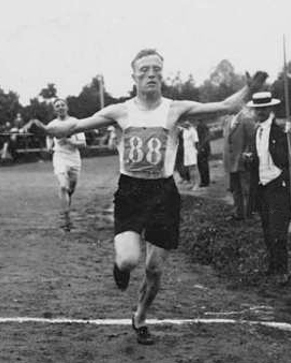1. Overview

Oskar Albinus "Albin" Stenroos (24 February 1889 - 30 April 1971) was a prominent Finnish long-distance runner who achieved significant success in his career, most notably by winning the marathon at the 1924 Summer Olympics in Paris. His athletic journey spanned various distances, from shorter track events to the demanding marathon, demonstrating remarkable versatility and endurance. This article details his early life, his progression through national championships and Olympic appearances, his world records, and his crowning achievement at the Paris Olympics, followed by his post-Olympic career and eventual retirement.
2. Early Life and Background
Albin Stenroos was born on 24 February 1889, in Vehmaa, Finland. He began his competitive running career early, participating in his first marathon in 1909. In this debut race, he secured a third-place finish at the national championships, marking the beginning of his notable career in athletics. Standing at a height of 68 in (173 cm) and weighing 141 lb (64 kg), Stenroos possessed a physique well-suited for endurance running.
3. Athletic Career
Albin Stenroos's athletic career was characterized by his adaptability and consistent performance across different long-distance events. He initially focused on marathons but later shifted to shorter track distances, eventually returning to marathon running for his most significant Olympic triumph.
3.1. Early Career and National Championships
After his initial marathon appearance in 1909, Stenroos transitioned to shorter distances, competing in races as short as 4.9 K ft (1.50 K m). His talent quickly became evident when he won the 33 K ft (10.00 K m) race at the Finnish national championships in 1910, establishing his reputation as a formidable runner. In the absence of his formidable rival, Hannes Kolehmainen, Stenroos dominated the Finnish national scene, securing multiple titles. He claimed the national championships in both the 16 K ft (5.00 K m) and 33 K ft (10.00 K m) events consecutively from 1912 to 1916. Additionally, he proved his prowess in cross country running, winning the national cross country title from 1915 to 1917. Throughout this period, he also set personal bests in various events, including a time of 4:10.5 for the 4.9 K ft (1.50 K m) in 1912, 8:54.1 for the 9.8 K ft (3.00 K m) in 1912, 15:24.0 for the 16 K ft (5.00 K m) in 1915, and 32:21.8 for the 33 K ft (10.00 K m) in 1912.
3.2. 1912 Stockholm Olympics
Stenroos made his Olympic debut at the 1912 Summer Olympics held in Stockholm, Sweden. In the highly competitive 33 K ft (10.00 K m) event, he earned a bronze medal, finishing behind his compatriot Hannes Kolehmainen. He also competed in the cross country event, where he finished sixth individually. His strong performance contributed significantly to the Finnish team's success, helping them secure a silver medal in the team cross country competition.
3.3. World Records
Albin Stenroos was also a record-breaker in road running, setting several world bests during his career. In 1915, he established his first world record for the 19 mile (30 km) distance, achieving a time of 1:48:06.2. He further improved this record in 1924, clocking an even faster time of 1:46:11.6 for the same distance. Additionally, in 1923, he held the world record for the 12 mile (20 km) road race with a time of 1:07:11.2.
3.4. 1924 Paris Olympics and Marathon Gold
After opting to skip the 1920 Summer Olympics in Antwerp, Stenroos made a pivotal decision to return to marathon running for the 1924 Summer Olympics in Paris, France. This marked his first marathon in 15 years since his debut in 1909. The race was held under extremely hot conditions, posing a significant challenge to all competitors. Despite these adverse circumstances, Stenroos delivered a remarkable performance, winning the gold medal decisively. He finished the race in 2:41:23, beating the second-placed Italian runner, Romeo Bertini, by a substantial margin of almost six minutes. This victory represented the pinnacle of his athletic career.
3.5. Post-Olympic Career and Retirement
Following his Olympic triumph, Stenroos continued to compete briefly. He participated in the prestigious Boston Marathon in 1926, where he achieved a commendable second-place finish. He returned to the Boston Marathon in 1927, but he was unable to finish the race, withdrawing during the competition. After this event, Albin Stenroos decided to retire from competitive athletics, concluding a distinguished career in long-distance running.
4. Death
Albin Stenroos passed away on 30 April 1971, at the age of 82. He died in Helsinki, Finland, leaving behind a legacy as one of Finland's most celebrated long-distance runners and an Olympic champion.